Xueqing Li
Bridging the Gap between Continuous and Informative Discrete Representations by Random Product Quantization
Apr 07, 2025Abstract:Self-supervised learning has become a core technique in speech processing, but the high dimensionality of its representations makes discretization essential for improving efficiency. However, existing discretization methods still suffer from significant information loss, resulting in a notable performance gap compared to continuous representations. To overcome these limitations, we propose two quantization-based discretization methods: Product Quantization (PQ) and Random Product Quantization (RPQ). PQ partitions the original feature space into multiple subspaces and independently quantizes each sub-vector, producing a fused set of discrete units that retain diverse information from different subspaces, thus mitigating the loss associated with single-cluster quantization. RPQ further enhances representation diversity by randomly sampling a fixed proportion of feature dimensions multiple times to construct sub-vectors, thereby better capturing the variability in the data distribution. Theoretical analysis shows that RPQ reduces the correlation coefficient rho (where 0 <= rho <= 1) between sub-quantizers. Its quantization error is lower-bounded by the product of rho and epsilon-kms, where epsilon-kms denotes the quantization error of a single K-means quantizer. Experimental results on a combined dataset built from LibriSpeech and ML-SUPERB show that PQ and RPQ outperform standard K-means discretization, achieving relative improvements of 21.8 percent and 20.0 percent in WER on LibriSpeech, and 24.1 percent and 19.6 percent in CER on ML-SUPERB, respectively. Moreover, their performance is competitive with, and in some cases even surpasses, that of continuous SSL representations.
TL-nvSRAM-CIM: Ultra-High-Density Three-Level ReRAM-Assisted Computing-in-nvSRAM with DC-Power Free Restore and Ternary MAC Operations
Jul 06, 2023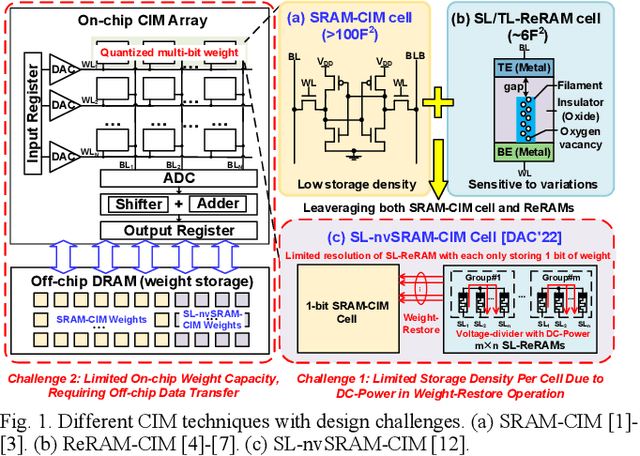
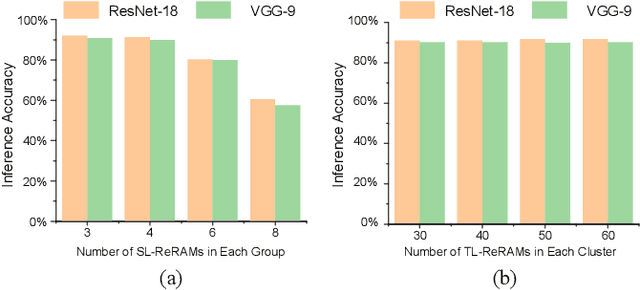
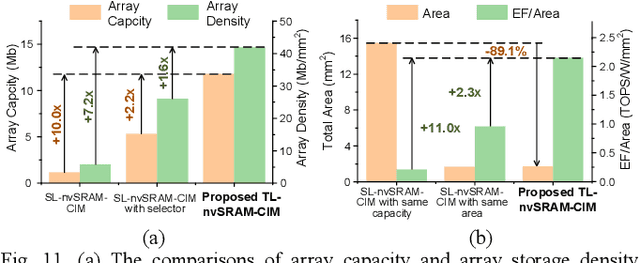
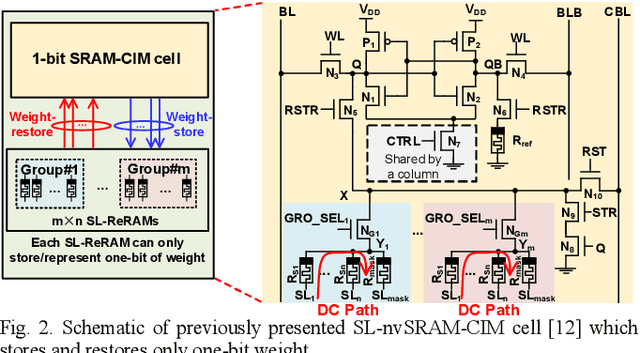
Abstract:Accommodating all the weights on-chip for large-scale NNs remains a great challenge for SRAM based computing-in-memory (SRAM-CIM) with limited on-chip capacity. Previous non-volatile SRAM-CIM (nvSRAM-CIM) addresses this issue by integrating high-density single-level ReRAMs on the top of high-efficiency SRAM-CIM for weight storage to eliminate the off-chip memory access. However, previous SL-nvSRAM-CIM suffers from poor scalability for an increased number of SL-ReRAMs and limited computing efficiency. To overcome these challenges, this work proposes an ultra-high-density three-level ReRAMs-assisted computing-in-nonvolatile-SRAM (TL-nvSRAM-CIM) scheme for large NN models. The clustered n-selector-n-ReRAM (cluster-nSnRs) is employed for reliable weight-restore with eliminated DC power. Furthermore, a ternary SRAM-CIM mechanism with differential computing scheme is proposed for energy-efficient ternary MAC operations while preserving high NN accuracy. The proposed TL-nvSRAM-CIM achieves 7.8x higher storage density, compared with the state-of-art works. Moreover, TL-nvSRAM-CIM shows up to 2.9x and 1.9x enhanced energy-efficiency, respectively, compared to the baseline designs of SRAM-CIM and ReRAM-CIM, respectively.
A 65nm 8b-Activation 8b-Weight SRAM-Based Charge-Domain Computing-in-Memory Macro Using A Fully-Parallel Analog Adder Network and A Single-ADC Interface
Nov 23, 2022



Abstract:Performing data-intensive tasks in the von Neumann architecture is challenging to achieve both high performance and power efficiency due to the memory wall bottleneck. Computing-in-memory (CiM) is a promising mitigation approach by enabling parallel in-situ multiply-accumulate (MAC) operations within the memory with support from the peripheral interface and datapath. SRAM-based charge-domain CiM (CD-CiM) has shown its potential of enhanced power efficiency and computing accuracy. However, existing SRAM-based CD-CiM faces scaling challenges to meet the throughput requirement of high-performance multi-bit-quantization applications. This paper presents an SRAM-based high-throughput ReLU-optimized CD-CiM macro. It is capable of completing MAC and ReLU of two signed 8b vectors in one CiM cycle with only one A/D conversion. Along with non-linearity compensation for the analog computing and A/D conversion interfaces, this work achieves 51.2GOPS throughput and 10.3TOPS/W energy efficiency, while showing 88.6% accuracy in the CIFAR-10 dataset.
UGRec: Modeling Directed and Undirected Relations for Recommendation
May 10, 2021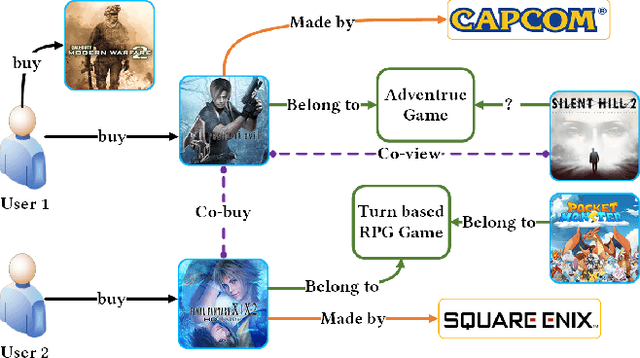

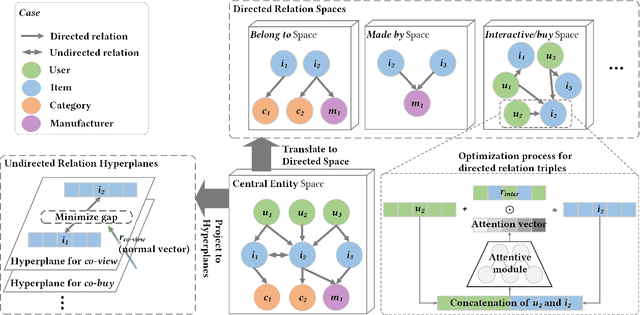

Abstract:Recommender systems, which merely leverage user-item interactions for user preference prediction (such as the collaborative filtering-based ones), often face dramatic performance degradation when the interactions of users or items are insufficient. In recent years, various types of side information have been explored to alleviate this problem. Among them, knowledge graph (KG) has attracted extensive research interests as it can encode users/items and their associated attributes in the graph structure to preserve the relation information. In contrast, less attention has been paid to the item-item co-occurrence information (i.e., \textit{co-view}), which contains rich item-item similarity information. It provides information from a perspective different from the user/item-attribute graph and is also valuable for the CF recommendation models. In this work, we make an effort to study the potential of integrating both types of side information (i.e., KG and item-item co-occurrence data) for recommendation. To achieve the goal, we propose a unified graph-based recommendation model (UGRec), which integrates the traditional directed relations in KG and the undirected item-item co-occurrence relations simultaneously. In particular, for a directed relation, we transform the head and tail entities into the corresponding relation space to model their relation; and for an undirected co-occurrence relation, we project head and tail entities into a unique hyperplane in the entity space to minimize their distance. In addition, a head-tail relation-aware attentive mechanism is designed for fine-grained relation modeling. Extensive experiments have been conducted on several publicly accessible datasets to evaluate the proposed model. Results show that our model outperforms several previous state-of-the-art methods and demonstrate the effectiveness of our UGRec model.
 Add to Chrome
Add to Chrome Add to Firefox
Add to Firefox Add to Edge
Add to Edge